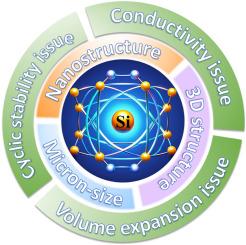From electrochemical performance to mechanical Issues: A review on silicon anode architectures for advanced lithium-ion batteries
IF 7.9
2区 工程技术
Q1 CHEMISTRY, PHYSICAL
引用次数: 0
Abstract
The increasing demand for high-energy-density lithium-ion batteries in electronics and electric vehicles has spurred significant research into silicon anodes. This article reviews key structural variants—nanostructured, micron-scale, and three-dimensional (3D) silicon anodes—highlighting their advantages, challenges, and solutions. While nanostructured silicon offers high specific capacity and stability, it suffers from low conductivity, significant volume expansion, and poor cycling life. To address these, strategies such as nanostructural Si designs, introducing conductive/buffering agents (e.g., graphene, MXene), and polymeric binders are discussed. Micron-scale silicon partially alleviates expansion due to its larger size, but still faces challenges in conductivity and cycling stability; morphological optimization strategies are explored. Conversely, 3D structured silicon demonstrates excellent electrochemical performance from its unique architecture, though conductivity and volume expansion remain issues. The review covers state-of-the-art methods, including the above approaches and functional additives, to achieve stable cycling. Finally, future development pathways such as novel structural designs, material innovation, and application prospects are considered, indicating silicon's potential as a robust anode material for future lithium-ion batteries.

从电化学性能到力学问题:先进锂离子电池硅阳极结构研究综述
电子产品和电动汽车对高能量密度锂离子电池的需求不断增长,刺激了对硅阳极的重大研究。本文综述了纳米结构、微米级和三维(3D)硅阳极的主要结构变体,重点介绍了它们的优势、挑战和解决方案。虽然纳米结构硅具有高比容量和稳定性,但它的导电性低,体积膨胀大,循环寿命差。为了解决这些问题,讨论了诸如纳米结构Si设计,引入导电/缓冲剂(例如石墨烯,MXene)和聚合物粘合剂等策略。微米级硅由于尺寸较大,部分缓解了膨胀,但在电导率和循环稳定性方面仍面临挑战;探索了形态优化策略。相反,3D结构硅由于其独特的结构表现出优异的电化学性能,尽管电导率和体积膨胀仍然是问题。本文综述了目前最先进的方法,包括上述方法和功能添加剂,以实现稳定循环。最后,考虑了未来的发展路径,如新颖的结构设计,材料创新和应用前景,表明硅作为未来锂离子电池的稳健负极材料的潜力。
本文章由计算机程序翻译,如有差异,请以英文原文为准。
求助全文
约1分钟内获得全文
求助全文
来源期刊

Journal of Power Sources
工程技术-电化学
CiteScore
16.40
自引率
6.50%
发文量
1249
审稿时长
36 days
期刊介绍:
The Journal of Power Sources is a publication catering to researchers and technologists interested in various aspects of the science, technology, and applications of electrochemical power sources. It covers original research and reviews on primary and secondary batteries, fuel cells, supercapacitors, and photo-electrochemical cells.
Topics considered include the research, development and applications of nanomaterials and novel componentry for these devices. Examples of applications of these electrochemical power sources include:
• Portable electronics
• Electric and Hybrid Electric Vehicles
• Uninterruptible Power Supply (UPS) systems
• Storage of renewable energy
• Satellites and deep space probes
• Boats and ships, drones and aircrafts
• Wearable energy storage systems
 求助内容:
求助内容: 应助结果提醒方式:
应助结果提醒方式:


